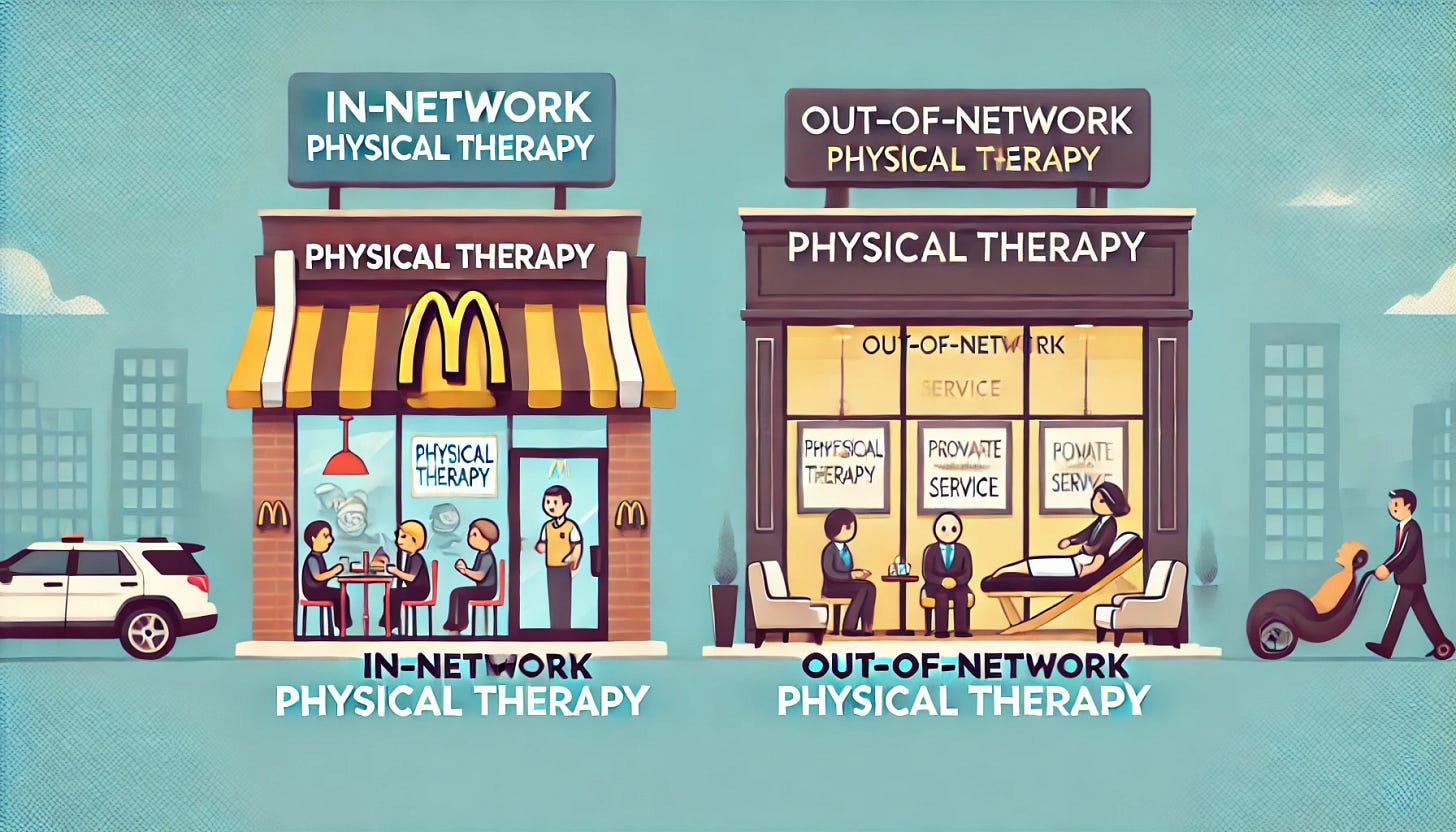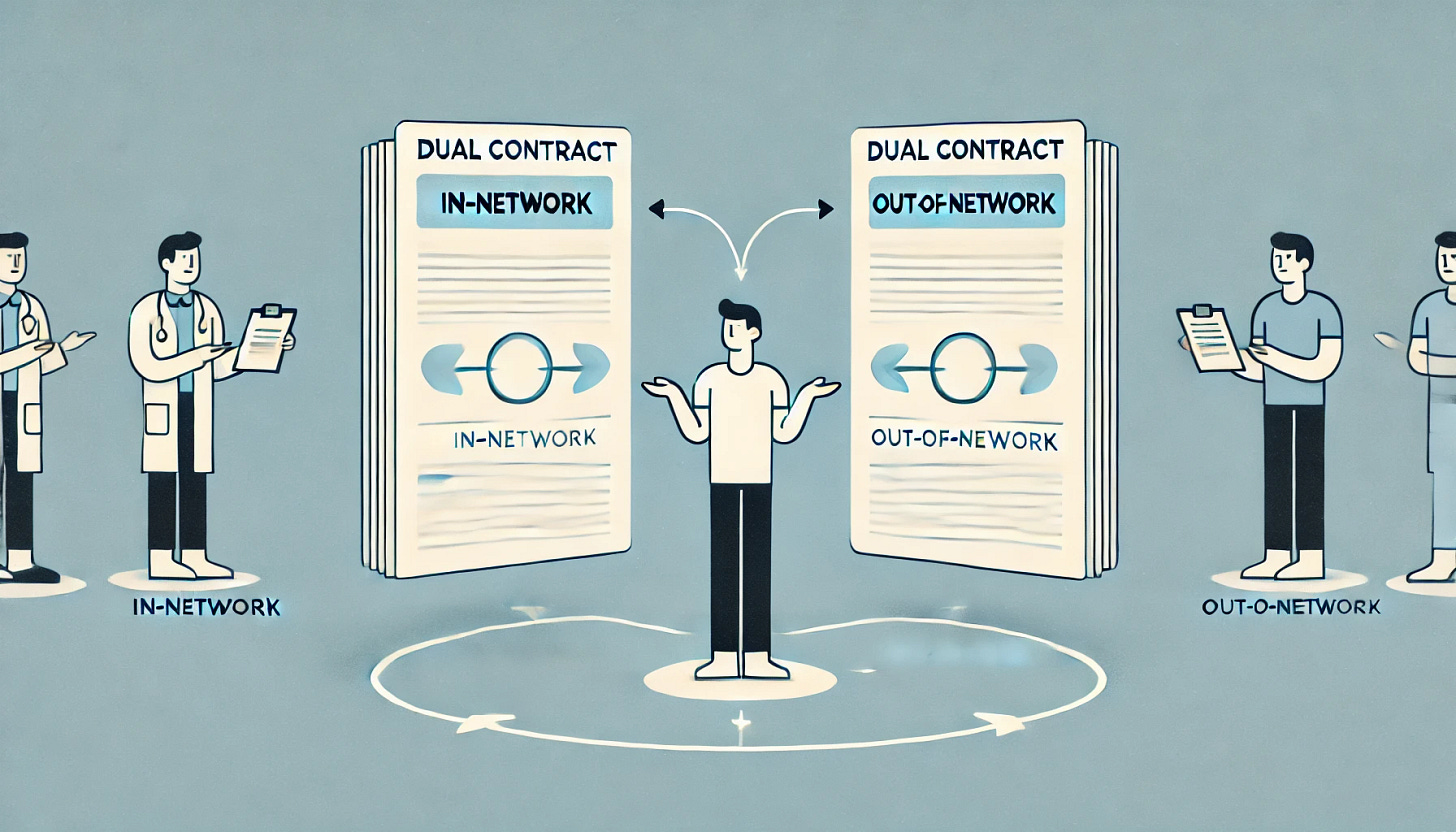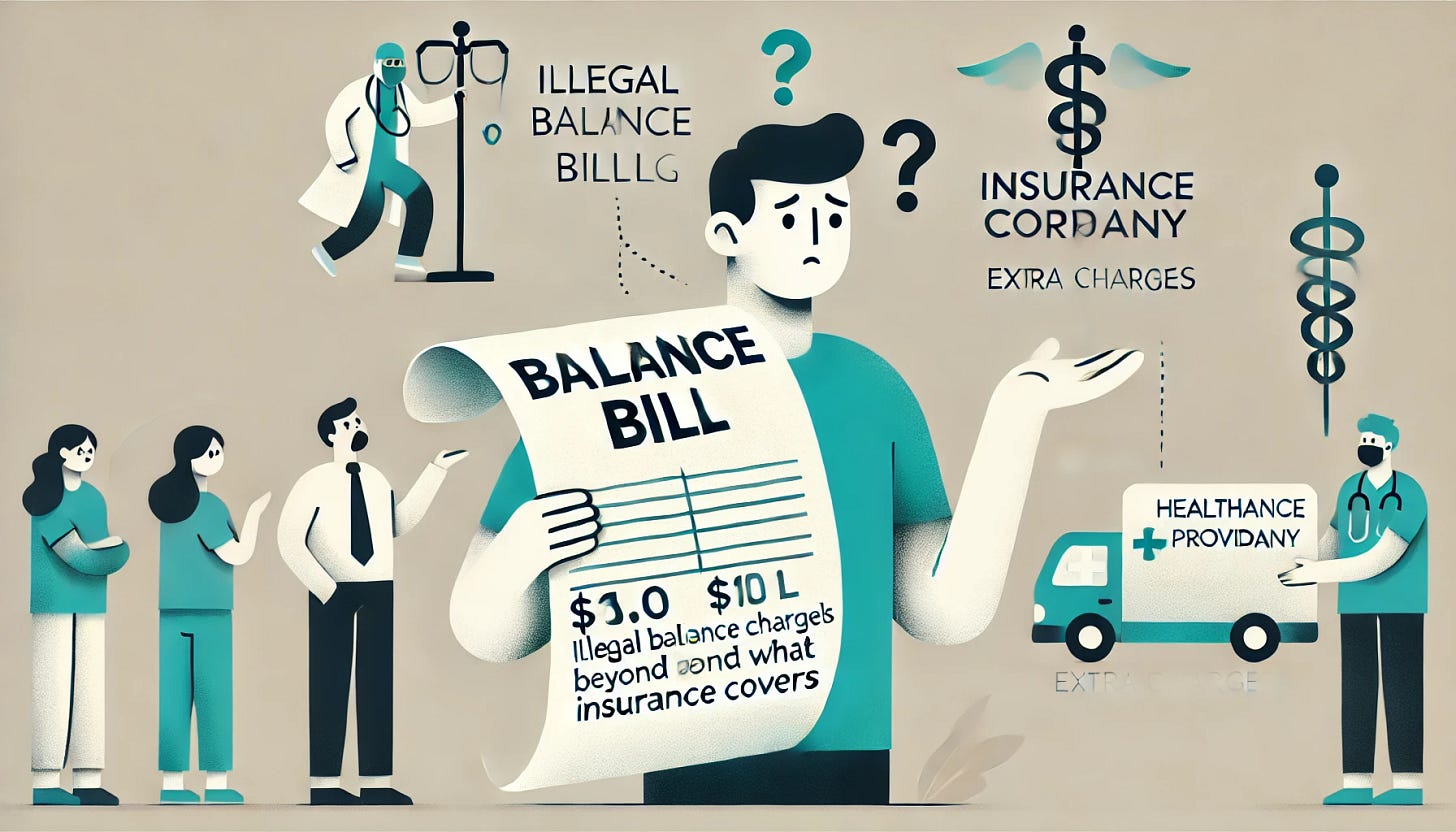The Dark Side of Musculoskeletal Care
The Top 7 Lies, Scams, and Insurance Manipulations
The MSK community largely faults the health insurance industry for many of the problems in today’s healthcare environment, but as the saying goes— people who live in a glass house shouldn’t throw stones. If we look inward to our own profession, especially when it comes to outpatient orthopedics and private practice, we will find a catalog of insurance machinations and manipulations that at best fall into the “grey area” of private practice, and at worst, considered fraudulent.
What I have listed below are some questionable or potentially unethical practices sometimes seen in the outpatient physical therapy world—particularly around in-network vs. out-of-network billing—and how they can negatively affect patients and therapists.
Of course, many PT clinics operate ethically and do not engage in such practices, but these examples illustrate red flags that patients and clinicians should be aware of. In general, the examples below are applicable to both PT clinics as well as other types of healthcare practitioners such as physicians and chiropractors.
If you are a patient, you will find the points below highly valuable to avoid a surprise bill and being taken advantage of financially for your outpatient physical therapy visits.
If you are a clinician, you will find the information below helpful in avoiding clinics that abuse your license and put you in legal jeopardy.
If you are a practice owner, manager, or executive- the information below can be used to ensure that your practice is compliant for regulatory purposes.
Before we get to the meat-and-potatoes, for those who aren’t familiar with in-network vs out-of-network, let’s briefly define what we’re talking about.
The terms in-network and out-of-network refer to a clinician’s contractual relationship with a patient's health insurance plan, and this significantly influences the cost of services for the patient and the insurance plan.
Clinicians who are in-network have formal agreements with specific health insurance plans to offer services at pre-negotiated rates. These rates are typically lower for the insurance company and therefore, they incentivize the patient to go this route by making the out-of-pocket expense (e.g. co-pay/co-insurance) cheaper for the patient. For the clinician, opting for in-network status with insurance companies can lead to more steady patient referrals. Essentially, clinicians are agreeing to lower their rate in exchange for a greater volume of patients.
In contrast, clinicians who are out-of-network do not have contracts with a patients’ health insurance plan, allowing them to set their own rates. These rates are based on what insurers would refer to as “usual, customary, and reasonable” charges for similar health professionals in a given geographical area. Regardless of how they are defined, out-of-network rates typically involve much higher payment from both the insurance plan and the patient. Insurance plans will often charge patients higher out-of-pocket costs (co-pays/co-insurance) to steer them away from seeing these clinicians and toward their in-network counterparts.
This is all fairly straightforward, but the complexity arises when you consider that some patients’ health insurance plans contain BOTH in-network and out-of-network benefits (meaning the patient can see both types of clinicians) and some contain ONLY in-network benefits (meaning the insurance will not cover out-of-network providers whatsoever). And the matter is further complicated when some clinicians in the same practice have in-network, while others have out-of-network status.
A common misconception is that an out-of-network clinician will be better- more safe or effective- than an in-network clinician. This isn’t necessarily true as network status has very little to do with treatment efficacy or clinician skill in a fee-for-service environment.
Okay, so with all of that on the table, without further ado, let’s get to the in-network/out-of-network schemes…
1. Misrepresenting Network Status
This typically occurs when a patient calls to make an initial appointment and asks the clinic if they “take my insurance”. The clinic tells patients that they do take their insurance in order to encourage them to schedule an appointment. In reality, they may not disclose whether they are in-network or out-of-network with the patient’s specific plan. If they are out-of-network, the patient might be billed unexpectedly high out-of-network fees, leading to large bills after the fact. The way to resolve this problem is for the patient to specifically ask the practice “do you participate with my plan” or “are you in-network with my plan” instead of “do you take my insurance?”
Why it’s done:
Out-of-network reimbursement rates are often higher than in-network rates. The clinic may collect higher payments from the insurance company (if the plan has out-of-network benefits) or from the patient (who may be subject to a higher deductible and co-insurance for out-of-network care).
2. Dual Contract Games
Following the previous deception, here is another insidious one you should be aware of. Dual contract schemes occur when a practice is contracted with an insurance carrier (in-network) for certain clinics or under certain clinicians’ IDs but also operates an out-of-network “side entity”. They might selectively route patients or claims through whichever entity reimburses more.
Why it’s done:
To maximize revenue the practice cherry-picks which patients or claims to bill as out-of-network (often those with good out-of-network benefits) and avoids the lower reimbursements from in-network rates. For patients, this leads to confusion about coverage and unexpected bills. They may be steered into more expensive out-of-network services without fully understanding their financial responsibility and that the practice could have billed them in-network resulting in a much lower bill.
3. The Network “Bait and Switch” Scheme
This is an off-shoot of the “dual contract games” scheme and this one can really hurt the clinician as well as the patient. A “bait and switch” occurs when a clinic (as a business entity) has an in-network contract with a particular insurance company, but one or more of the physical therapists (or other clinicians) working there do not individually participate in that same insurance network. In other words, the clinic and certain therapists may be credentialed as in-network, while another therapist on staff remains out-of-network—even though they all practice under the same roof.
You’ve probably heard stories about how a patient may go to a hospital for a procedure and the facility and services are covered but somehow the anesthesia isn’t covered by the insurance because the anesthesiologist is out-of-network. This is a similar issue and you might be wondering how this sort of thing can even happen. Read on…
Outpatient PT clinics often have a “group” contract with an insurance carrier, tied to the clinic’s tax ID. Each individual clinician may also need to be credentialed with that insurer in order to be considered in-network personally. In some cases, a clinic might hold a group contract, but a specific therapist either never completed or failed the credentialing process—or the therapist or clinic specifically chooses to keep that clinician out-of-network for financial reasons.
At this point, a few things can happen when it's time to bill the insurance for the visit:
1. The in-network clinic bills under the group’s contract and the insurance claim typically goes out under the clinic’s tax ID. The therapist performing the service is also identified on the claim (via their NPI). If the therapist is not credentialed, an insurer may reject or reduce payment for that therapist’s services—or flag it as out-of-network—resulting in higher patient costs.
Or
2. The clinic might attempt to “hide” the fact that the therapist is out-of-network by billing under another therapist’s NPI or otherwise misrepresenting the rendering clinician (which can be considered fraudulent).
Or
3. The clinic will purposefully bill under the out-of-network clinician even though the clinic itself is in-network. The insurance company will pay for the claim and make the check payable to either the patient or the rendering clinician. The insurance company files 1099 forms with the IRS under the clinician’s tax ID, showing those out-of-network payments as the clinician’s income.
If the clinician is unaware or never receives proper statements, they do not report this additional income on their taxes. When the IRS compares the clinician’s tax return (W-2 wages, or other reported income) with the 1099s it has on file from the insurance company, it sees a discrepancy. Resultant, the clinician could face penalties or audits due to “underreporting” income—even though they never actually received or kept that money.
Why it’s done:
Again- to maximize revenue. The practice cherry-picks which patients or claims to bill as out-of-network. This subjects the patient to potential higher out-of-pocket costs and opens up the practice and the therapist to potential insurance fraud, tax evasion, and other legal exposure. The worst thing about all of this is that the therapists and other clinicians are not well-educated on the business aspect of clinical care and may often not even realize what is happening under unscrupulous management practices. If patients discover they were unknowingly receiving care from an out-of-network therapist in an “in-network” clinic, they may blame the therapist or the clinic for surprise bills. This can harm the therapist’s professional reputation and patient rapport. Finally, if patients can’t afford the unexpectedly higher out-of-network costs, they may have to discontinue or seek care elsewhere—disrupting continuity of care.
4. Inappropriate “Balance Billing”
When a clinic is out-of-network, they often receive a lower portion of their charges from insurance. Some unscrupulous practices will then bill the patient the difference between the clinic’s full “cash rate” and what the insurance company paid, despite contractual or state law prohibitions on certain balance-billing practices.
Why it’s done:
The clinic aims to collect more money by passing on the insurer’s discounted or partial payment shortfall to the patient. This results in the patient receiving unexpected, often large bills that were not initially explained, creating financial burden or leading patients to avoid future physical therapy care.
5. Waiving Copays to Induce More Visits
A clinic might tell patients, “Don’t worry about your copay,” to entice them to come more frequently. However, most insurance contracts prohibit routine waiving of copays and deductibles.
Why it’s done:
By removing any out-of-pocket costs, the clinic makes it more appealing for patients to return, which can lead to more billable services. In some instances, the clinic may falsely inflate charges or number of visits to offset waived copays. If discovered by the insurer or regulators, patients may face retroactive billing for copays or run into coverage issues in the future. In extreme cases, the insurance plan might refuse to pay claims or could even drop coverage.
6. Upcoding Services
A clinic might use a higher-paying code for a procedure that was actually something simpler (referred to as “upcoding”). For example, if billing for neuromuscular re-education results in higher reimbursement than therapeutic exercise, the clinic may bill for the former even when the latter was the service actually rendered. Sometimes this can get tricky because there is service overlap, so how these services are documented often determines its defensibility.
Why it’s done:
Increases the total billable amount per visit, especially out-of-network (where there is generally less oversight and fewer contract rules). This could lead to higher out-of-pocket costs (copays, co-insurance, deductibles). This may also flag the patient in their insurer’s system if there are irregular billing patterns, such as regularly billing for physical therapy re-evaluation when only a progress note was completed. Insurers sometimes suspect fraud and may delay or deny legitimate claims. They may also retroactively request payment from the clinician or practice.
7. Over-utilization of Services
This is the most common scheme, used in most healthcare facilities. The reason being is that it is largely a grey area. Depending on documentation, additional services can be justified from a legal perspective. Overutilization manifests in the form of scheduling more PT visits than are clinically necessary, or adding unnecessary treatments or modalities each session to justify higher billing.
Why it’s done:
Each additional visit or service can bring in more revenue, especially if billed at out-of-network rates. For patients, this results in increased cost sharing (co-insurance) for visits and treatments that may not be necessary, as well as wasted time and possible discouragement from continuing necessary care in the future due to financial burdens.
So there you have it: the dark side of clinical practice. Some outpatient physical therapy clinics and other private practices exploit in-network vs. out-of-network differences by misrepresenting their network status, overbilling services, engaging in excessive or unnecessary treatments, or improperly balance-billing patients. These tactics can saddle patients with unexpectedly high costs and undermine trust in the healthcare system. They also hurt therapists who put their license at risk, and may face legal and financial repercussions by other entities such as the IRS. By being informed, patients and good clinicians out there can protect themselves from these unethical practices.









Insightful, thank you, Dr. Paul!